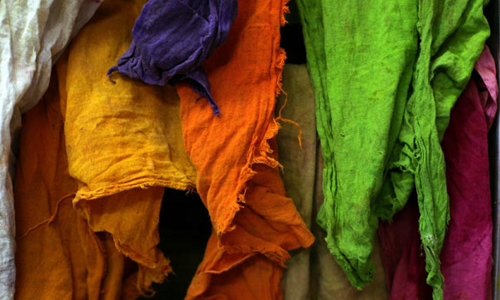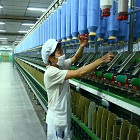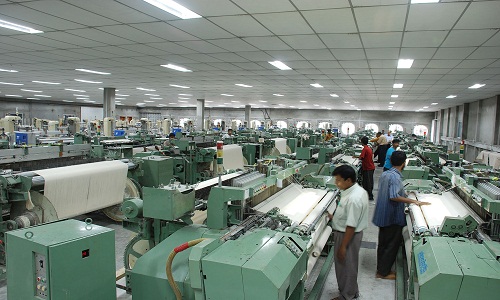FW
Used clothing imported in the garb of garments, unstitched cloth under red channel, will be examined 100 per cent by the Federal Board of Revenue (FBR). This will help facilitate the textile sector and remove apprehension about this, along with quick payment of duty drawback and valuation ruling for used cloth. Sources say the FBR Model Customs Collectorates (MCCs) have been issued instructions by the FBR on textile-related issues after a meeting with the All Pakistan Textile Mills Association (APTMA).
Key measures regarding the textile sector have been implemented at the FBR’s field formations level after the instructions. The FBR informed customs collectors about a meeting with APTMA by the Advisor to Prime Minister on Revenue in FBR, wherein, the import of unstitched cloth and new garments in the garb of used clothing was agitated by APTMA. Thus, the collectorate should place any unstitched fabric and or new garments that may be concealed in the used clothing, under red channel for hundred per cent examination and the Board should be notified about this immediately.
The Model Customs Collectorates have also been instructed that the valuation of used cloth also comes under this and that the matter may be looked into for fixing a fair import value. Special instructions have been issues to the Collector of Customs, Faisalabad to speed up the payment of duty drawback to the textile exporters. Besides, the value of foreign origin imported cloth would also be revisited.
To facilitate nonwovens fabric suppliers’ expansion in China, where imports of such products jumped 128 per cent from 2000 to 2013, this year Messe Frankfurt (HK), is set to launch a new initiative. The China International Nonwovens Expo & Forum (CINE- supported by Techtextil) from October 14-16, 2015, will be launched by the German exhibition company’s Asia Pacific branch. To be held in Shanghai Mart, the three-day event combines a trade expo and industry forum.
Senior general manager, Wendy Wen is optimistic about the continuing potential in China’s nonwovens market as imports grew from 61,400 to 140,000 tons between 2000 and 2013. This momentum will continue in the coming years, she feels. Many nonwovens exhibitors were confident that, by participating in the event, they will be able to expand their business in China, where imports of such products were high in demand, Wen added.
The unit price of imported nonwovens reached $6.1 per ton in 2013, which is 35 per cent higher than in 2007, as per statistics complied by the China Nonwovens & Industrial Textiles Association. A parallel forum will be a platform for show participants to learn about all-round information of worldwide nonwovens market apart from providing sourcing options to buyers.

A big fashion carbon footprint

Eileen Fisher, a clothing industry magnate, known for her commitmentfast fashion 1 to environmental causes explains fashion is a complicated business that involves a long and varied supply chain, raw material, textile manufacture, clothing construction, shipping, retail, use and ultimate disposal of the garment. Fashion carbon footprint is huge and a assessing how much it is, by itself is an overwhelming task. A general assessment needs to take into account the obvious pollutants like pesticides used in cotton farming, toxic dyes used in manufacturing and great amount of waste discarded clothing creates while also looking at the extravagant amount of natural resources used in extraction, farming, harvesting, processing, manufacturing and shipping.
Cotton, and especially organic cotton can consume more than 5,000 gallons of water to manufacture a T-shirt and a pair of jeans. On the other hand, synthetic, man-made fibres, may not use so much water, but often have issues with manufacturing pollution and sustainability. Also, across all textiles, the manufacturing and dyeing of fabrics is chemically intensive.
Moreover, globalisation means a garment has been across the globe in a container ship running on the dirtiest of fossil fuels. Besides, the current trend in fashion retail creates a great demand for quick and cheap clothes, which is another big issue. After purchase too, your clothes pose a threat to the environment from washing and final disposal when you’re finished with the garment may cause more harm to the planet than one realises.
Dyes too are harmful as they create a chemical Fukushima in Indonesia and the Citarum River is considered one of the most polluted rivers in the world, partly because of the textile factories lined up on its shores. With 68 per cent of the industrial facilities on the Upper Citarum producing textiles, the adverse health effects on five million people living in the river basin and wildlife are alarming, as per Greenpeace.
More than 60 per cent world clothing is manufactured in developing countries although, majority of the world’s apparel conglomerates are US-based. Asia produces more than 32 per cent of the world’s supply, making it a major exporter of clothing. The leading producer and supplier is China, and comprises nearly 13 per cent of the world’s exports.
Overhaul need of hour
Clothing companies are moving to countries where manufacturing is cheaper, as production and labour costs are on the rise in China. Countries like Bangladesh, Vietnam, Pakistan and the Philippines are where manufacturing happens, but they do not have the raw materials, which is most often shipped from countries such as India, China, and the US. Once manufactured, the garments are sent by rail, container ships and eventually rail and trucks to the retailer. Loads of fuel is used to ship these garments across the world.
Realising the impact on environment, some designers are refurbishing the fashion industry. For example, Fisher’s company is already using 84 per cent organic cotton, 68 per cent organic linen and uses less water and carbon emissions and is working to make its supply chain sustainable by 2020. But as Fisher said, hers is just one company and the impact is rather small. The real change would come about when big, affordable brands start selling sustainable clothing.
Bangladesh’s textile and apparel industry has attracted scholars and policymakers’ attention from across the world, feels Tofail Ahmed, Commerce Minister. This is because of women’s employment, increasing contribution to the country’s poverty reduction and the country’s healthy export performance in the last three decades. Bangladesh is now the world’s second-largest exporter of RMG and the sector is also the country’s leading export earner and garner’s $25.5 billion or 82 per cent of total exports.
After the US, Germany is the second-largest export destination of Bangladeshi products. It shares around 16 per cent of the total export earnings. Bangladesh’s export to Germany amounted to $5012.45 million in 2014-15 and over the last two years exports to Germany has grown significantly, giving rise to favourable trade with Bangladesh.
Bangladesh now has plans to reach $50 billion exports from RMG and apparel industry by 2021. Bangladesh’s strong performance, is because of the advantages the country has in terms of price and capacity and liberalisation of the RMG sector through phasing out of quota and duty free access provided by the major trading nations of the world.
Spinning mills want interest subvention scheme for yarns and clothes exports, since interest cost is a major roadblock towards profitability. Most small and medium sized mills are expected to make losses at the net level in the fiscal 2015-16. The downward trend is affecting negatively with stocks piling up due to a fall in demand which is leading to a financial crisis.
Another problem mills are facing is that existing orders are being re-negotiated due to the yuan’s devaluation. This has affected the farm sector with payment delays on cotton purchased by mills. The interest subvention is expected to give a thrust to yarn and clothes exports due to competitive pricing and the gap created by this would be filled up through supplies from the domestic sector.
Interest subvention is a subsidy offered on interest rates. It’s offered on several lending schemes by the government to promote a particular industry. With the subsidy in hand, the loan borrower does not have to pay total interest on the loan amount. Some part of it is borne by the government.
With the interest subvention in hand, the EMI of the borrower comes down by percentage of interest subvention borne by the government.

Textile mills that processed cotton and wove it into cloth were once a monopoly of the southern US states before World War II. However, in the past 50 years, free trade agreements, automation and competition from countries such as China have affected these mills. Eventually, their businesses have touched ground zero. However, now, some textile jobs are making a comeback, but in a different way. As The New York Times reports, some Chinese manufacturers are setting their businesses in the US, after realising that it is cheaper to manufacture their products in Southern America than in China.
South offers lucrative business prospects

A Chinese yarn-maker, Keer Group, is investing $218 million in a US-2factory in South Carolina, while JN Fibers, another Chinese manufacturer, is investing $45 million in the same region. Then, there’s Shri Vallabh Pittie, an Indian company that is investing $70 million in a yarn-spinning plant in Sylvania, Ga. Other industries too are witnessing a change, Fuyao, a Chinese auto glass maker is investing in a $230 million production facility in Ohio. Besides, several Chinese manufacturers are expanding their capacity at Cirrus Aviation in Minnesota and Nexteer Automotive in Michigan.
The difference between the cost of manufacturing something in the US and in China has narrowed considerably, as per an index created by Boston Consulting. A product that could be manufactured for $1 in the US in 2004 could be produced for 85.6 cents in China. Ten years down the line, $1 for the product in the US would cost 95.6 cents if manufactured in China, which was not much in savings.
The reasons for the shift are many, though the cost differences haven’t changed much. For instance, Americans are still earning more wages than the Chinese workers are. According to figures from the Boston Consulting Group, Chinese workers made $12.47 an hour in 2014, which was slightly more than half of what American workers made at $22.32 an hour.
There are other factors that have made up for the difference in cost of doing business in the US. The state and local governments, for example, offer plenty of tax breaks and subsidies to companies that set up business in their jurisdictions. Besides, decrease in the cost of electricity, due to US’ natural gas boom, has attracted energy-intensive manufacturing industries. Also, as China’s economy has developed, wages have gone up, and thus the costs of land, energy and other raw materials.
Boston Consulting Group’s data shows that even when adjusted for productivity, over the past 10 years, wages of Chinese workers have risen by 187 per cent. Industrial electricity costs have gone up 66 per cent, while natural gas costs have risen by 138 per cent. The US wages, in the same timeline, have increased by only 27 per cent, while natural gas costs have dipped by 25 per cent.
Experts say, it is a lot easier to manufacture in the US products where Chinese companies need access to qualified labour or proximity to American consumers, but don’t need lots of low-cost labour. Chinese investment in the US though, remains small, but as some data by the Rhodium Group reveals, it is bringing tangible economic benefits in the form of jobs.
As far as manufacturing jobs in the US are concerned, it will never be the same as the 80’s, as industries are much more automated today. However, more skilled manufacturing jobs would act as a boon to the country’s economy. These workers are better paid, as manufacturers today need more highly trained workers who know how to operate automated systems.
Yet, China still is powerful where manufacturing is concerned, for the move out of the country applies to new industries and not existing ones.
In an attempt to realise Punjab chief minister, Shahbaz Sharif’s dream of turning the proposed Quaid-e-Azam Apparel Park in Sheikupura in Pakistan into the most modern project of South Asia, Punjab Industrial Estates (PIE) Development and Management Company has signed a contract with China Textile Network Company Limited. Under the contract, the Chinese firm will carry out a detailed designing of power plant, infrastructure, Combined Effluent Treatment Plant and grid stations for the set up of the apparel park.
The PIE Chairman, S M Tanveer, says that the Chinese, accorded the task, is a leading multinational firm and specialised in apparel and textile sector. The project the firm is supposed to work on, once completed not only will give a boost to the textile and garments sector but also play a terrific role in the growth of the economy. The park boasts of all necessary facilities for the apparel sector under one roof. It will also generate employment for thousands and will be instrumental in revving up the export of the country in this sector. The firm will also help the in marketing and promotional activities.
East African countries, particularly Ethiopia and Kenya, are fast emerging as leading clothing manufacturers. However, there governments, employers and buyers need to pull together and improve business conditions. Since 2013, buyers – among them H&M, Primark and Tesco — have been increasingly sourcing from East Africa, helped by the renewal of the African Growth and Opportunity Act (AGOA), which gives certain countries in sub-Saharan Africa duty-free access to the US market.
Apparel exports from Ethiopia, Kenya, Tanzania and Uganda amounted for a combined $337 million in 2013. Bangladesh remains at the top of the list of future sourcing destinations, followed by Vietnam and India, but East Africa is clearly on the rise. Sub-Saharan Africa, East African countries—especially Ethiopia and Kenya, and to a lesser extent Uganda and Tanzania—are of interest to apparel buyers. Both Ethiopia and Kenya are taking steps to develop their domestic textile and garment industries.
However, if East Africa is to enjoy sustainable growth in garment manufacturing, governments should consider investing in infrastructure, supporting local entrepreneurs, diversifying free trade agreements and building market-oriented educational institutions. Suppliers will also need to upgrade their facilities and enter into long-term partnerships with buyers, while buyers will need to evaluate the region as a true strategic option rather than just a testing ground.
The Integrated Skilled Development Scheme introduced in India in 2010 -11 to address the manpower requirements of textiles and related segments has a target to equip 15 lakh people by the end of March 2017. It’s expected to help overcome the shortage of skilled workforce in textile sector and become a growth driver in the industry and trigger innovation and scale.
The government provides a grant subsidy of 75 per cent of the project cost with a ceiling of Rs 10,000 per trainee. So far around 4.20 lakh candidates have been successfully trained across diverse sectors like apparel and garments, textiles, handlooms, handicrafts, sericulture, technical textiles, jute etc. Around 3,250 training centers are there across states, cities and rural areas including remote locations, backward regions and left wing extremism-affected areas.
During 2010, around six projects were sanctioned under the scheme. This has increased progressively to 57 in the year 2014 and 76 in the year 2015-16. The scheme was revamped in 2014-15, with a view to simplifying procedures and focusing on partnering with industry for scaling up of implementation of the training program with assured employment.
Steps have been taken to devise strong monitoring norms and to enhance the quality of training. There has been a continuous endeavor towards digitisation of skill development initiatives.
India's acreage under cotton during the ensuing 2015-16 season is going to be less than that of the current crop year. Yield is, however, likely to be higher during the 2015-16 crop season due to good and timely rainfall in the cotton growing areas. Production for the 2015-16 season, therefore, is expected to be similar to that of the 2014-15 crop year. However, yield may go up due to timely rainfall in the cotton growing areas and the crop for the next cotton season is expected to match the previous year’s figures.
The total cotton supply in the next season is estimated at 470.65 lakh bales while the domestic consumption is pegged at 325 lakh bales, leaving a surplus of 145.65 lakh bales for exports. Mill consumption is estimated to be 285 lakh bales with demand from small scale units and non-mills also supporting the bullish trend in consumption.
The Cotton Corporation of India has procured about 87 lakh bales to provide price support to farmers. However it may not be able to sell a sizeable quantity of cotton at the end of the season. Global cotton output is estimated to decline by nine per cent in the crop year 2015-16 on diversion of acreage to other remunerative crops.












